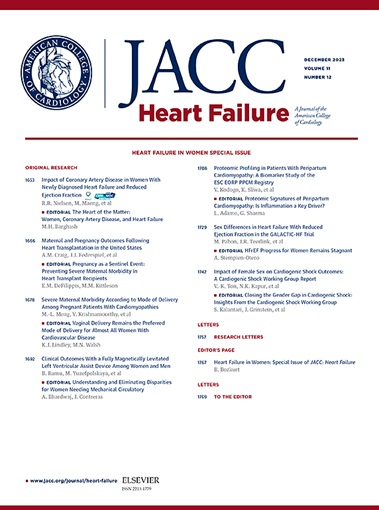Transferrin Saturation Is a Better Predictor Than Ferritin of Metabolic and Hemodynamic Exercise Responses in HFpEF
IF 10.3
1区 医学
Q1 CARDIAC & CARDIOVASCULAR SYSTEMS
引用次数: 0
Abstract
Background
Iron is a critical factor in cardiac function, oxygen carrying capacity in the blood, and mitochondrial function in skeletal muscle, all of which are key elements of oxygen uptake and utilization during exercise. However, the impact of iron status on hemodynamic responses to exercise and component variables of peak oxygen consumption in patients with heart failure with preserved ejection fraction (HFpEF) is unknown.
Objectives
The authors sought to determine the relationship between markers of iron status and comprehensive exercise response patterns and clinical outcomes in patients with HFpEF.
Methods
Cardiopulmonary exercise testing using cycle ergometry with invasive hemodynamic assessment was performed in 372 patients with HFpEF. Serum iron, transferrin saturation (Tsat), hepcidin, and ferritin were measured at the time of cardiopulmonary exercise testing, and additionally the Tsat/hepcidin ratio was used as a measure of iron homeostasis and hepcidin dysregulation, with low values reflecting inappropriate elevation in hepcidin level relative to iron bioavailability.
Results
In this cohort, 66% had iron deficiency defined as ferritin <100 μg/L or ferritin 100-300 μg/L with Tsat <20%. Higher peak oxygen consumption was associated with higher Tsat% (ρ = 0.33; P < 0.0001), Tsat/hepcidin ratio (ρ = 0.23; P < 0.0001), and serum iron (ρ = 0.30; P < 0.0001) but was not associated with ferritin level. After adjustment for age, hypertension, diuretic use, hemoglobin level, and cardiac index at rest, the association between higher peak oxygen consumption with higher Tsat, Tsat/hepcidin, and iron remained significant (P ≤ 0.006 for all). Tsat, Tsat/hepcidin, and iron were also associated with lower pulmonary artery pressure/cardiac output slope and pulmonary capillary wedge pressure/cardiac output slope, whereas ferritin did not correlate with these exercise hemodynamic measures. Finally, Tsat independently predicted heart failure-free survival, with every higher tertile of Tsat corresponding to an HR of 0.60 (P = 0.002), whereas ferritin was not associated with outcomes.
Conclusions
In patients with HFpEF, Tsat%, but not ferritin levels, relates to more favorable overall metabolic and hemodynamic responses to exercise and better outcomes.
转铁蛋白饱和度比铁蛋白更能预测HFpEF患者的代谢和血流动力学运动反应
diron是影响心脏功能、血液携氧能力和骨骼肌线粒体功能的关键因素,而这些都是运动过程中氧气摄取和利用的关键因素。然而,铁状态对运动后血流动力学反应和保留射血分数(HFpEF)心力衰竭患者峰值耗氧量组成变量的影响尚不清楚。目的:作者试图确定HFpEF患者铁状态标志物与综合运动反应模式和临床结果之间的关系。方法对372例HFpEF患者进行循环几何法心肺运动试验和有创血流动力学评估。在心肺运动试验时测定血清铁、转铁蛋白饱和度(Tsat)、hepcidin和铁蛋白,此外,Tsat/hepcidin比值被用来衡量铁稳态和hepcidin失调,较低的值反映了hepcidin水平相对于铁的生物利用度的不适当升高。结果66%的患者缺铁,定义为铁蛋白100 μg/L或铁蛋白100-300 μg/L,其中铁蛋白100 μg/L占20%。较高的峰值耗氧量与较高的Tsat%相关(ρ = 0.33;P & lt;0.0001), Tsat/hepcidin比值(ρ = 0.23;P & lt;0.0001),血清铁(ρ = 0.30;P & lt;0.0001),但与铁蛋白水平无关。在调整了年龄、高血压、利尿剂使用、血红蛋白水平和静息时心脏指数后,较高的峰值耗氧量与较高的Tsat、Tsat/hepcidin和铁之间的相关性仍然显著(所有P≤0.006)。Tsat、Tsat/hepcidin和铁也与较低的肺动脉压/心输出斜率和肺毛细血管楔压/心输出斜率相关,而铁蛋白与这些运动血流动力学指标无关。最后,Tsat独立预测无心力衰竭生存,Tsat每高一分位数对应的HR为0.60 (P = 0.002),而铁蛋白与预后无关。结论在HFpEF患者中,Tsat%而非铁蛋白水平与运动后更有利的整体代谢和血流动力学反应以及更好的预后相关。
本文章由计算机程序翻译,如有差异,请以英文原文为准。
求助全文
约1分钟内获得全文
求助全文
来源期刊

JACC. Heart failure
CARDIAC & CARDIOVASCULAR SYSTEMS-
CiteScore
21.20
自引率
2.30%
发文量
164
期刊介绍:
JACC: Heart Failure publishes crucial findings on the pathophysiology, diagnosis, treatment, and care of heart failure patients. The goal is to enhance understanding through timely scientific communication on disease, clinical trials, outcomes, and therapeutic advances. The Journal fosters interdisciplinary connections with neuroscience, pulmonary medicine, nephrology, electrophysiology, and surgery related to heart failure. It also covers articles on pharmacogenetics, biomarkers, and metabolomics.
 求助内容:
求助内容: 应助结果提醒方式:
应助结果提醒方式:


